In this article I provide a brief overview of the development of supported standing
TOMT subscribers can access more detailed analysis and video clips by clicking on the blue highlighted links. Subscribe here
From about the age of 8 months, typically developing infants learn to pull up into standing, using flat hand support or grip on suitable surfaces in the home environment.



Learning to balance in standing
Initially their balance is precarious, and it takes time and practice to figure out how to position and align the trunk, hands and lower extremities (LEs) to establish a configuration that maintains the CoM over the BoS as they play in standing, reach in all directions, and learn to lower themselves to sitting on the floor again.
Initially infants tend to take a fair amount of weight on one, or both upper limbs, and sometimes lean against the supporting surface to free one, or both hands, for playing.


With practice, infants learn to shift all their weight onto the lower extremities (LEs), and align the trunk over the feet with more hip extension and use hand contact with the supporting surface for balance rather than support.


Standing with the trunk aligned over the lower limbs, infants learn adjust the weight distribution over the LEs so as to maintain the CoM over the BoS.
When this adjustment is successful the infant will often stand with the weight on one LE and the contralateral UE, in this way expanding the BoS laterally. and in the A-P direction.
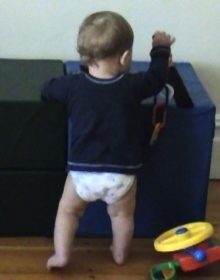

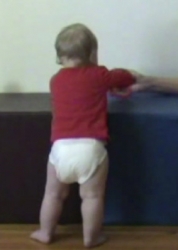
At other times the infant is less successful at keeping the CoM over the BoS, and a fall ensues.
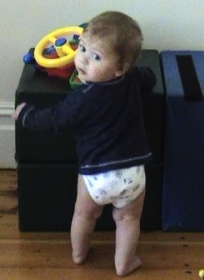
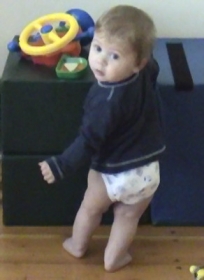

Infants also learn to take a step to adapt the BoS to maintain balance.

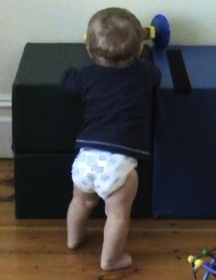
Reaching down to retrieve a toy from the floor
Once the infant has learned to balance in supported standing they start to reach down to retrieve a toy from the floor.
Initially they achieve this by tipping the trunk forwards and flexing the hips. But as their control of knee extension improves infants start to bend their knees as they reach down.
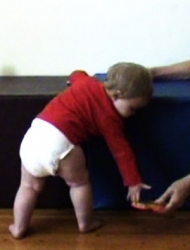
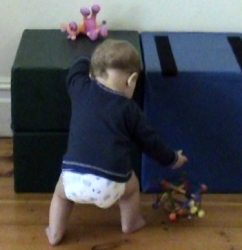
Sitting down
Initially infants initiate sitting down by leaning back on the feet with the knees in extension, tipping the trunk forwards and "falling" down into a sitting position.


With practice they learn to flex the hips and knees, squat down and then lower their buttocks onto the floor.


Pull-to-stand
Infants quickly learn to transition from kneeling to standing with support.
Initially the pattern of movement mostly involves hip and knee extension.




But over time and with practice the infant learns to rise to standing through half kneeling.



Stepping
Once typically developing infants have learned to balance in standing, and are able to shift their weight onto one LE, they will start to take small steps.
Stepping sideways is often initiated by a desire to reach a toy that is just out of reach. The direction of the step and final alignment of the LEs depend on the action that follows the step - picking up a toy, knocking over a tower etc.



Infants also take small steps to realign the base of support under the COM.
Cruising
Cruising differs from stepping in that the infant takes a series of steps with a defined stance and swing phase for each lower extremity. There is a smooth transition from stance to swing phase for each LE.
During the stand phase to COM is translated laterally and the stance hip moves from abduction into adduction as the trunk moves laterally over the supporting limb.

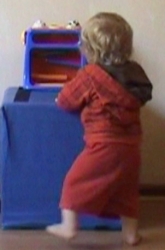


Postural sway
The other aspect of maintaining balance in upright standing is integrating and weighting the sensory information from different sources (touch, proprioception, vestibular and visual) needed for estimating the position of the body as a whole. This integration is reflected in the presence and extent of postural sway.
This video clip of Will (aged 9 months) clearly illustrates the postural sway as reflected in the ongoing lateral and anterior-posterior sway of the pelvis as the infant explores the boundaries of the postural envelope - ie the extent and direction of movement of the CoM compatible with maintaining balance from moment to moment.
Calibration of hip and knee muscle activity
Experience in standing also allows infants also allows infants to learn to calibrate the amount of lower limb muscle activation that is needed to support the body, allowing for adaptable amount of hip and knee extension as the infant rotates the trunk over the lower limbs, transfers weight in order to take a step and flex their knees to reach down to retrieve a toy, or lower the buttocks as they sit down.
In this sequence of frames you see Will reaching down to pick up a toy. He carefully flexes his hip but does not quite manage to keep the CoM aligned over the BoS and looses his balance as he reaches a full squat.
References
Atun-Einy O, Berger SE, Scher A. Pulling to stand: common trajectories and individual differences in development. Dev Psychobiol. 2012 Mar;54(2):187-98.
Ossmy, O., & Adolph, K. E. (2020). Real-Time Assembly of Coordination Patterns in Human Infants. Current biology : CB, 30(23), 4553–4562.e4. https://doi.org/10.1016/j.cub.2020.08.073
